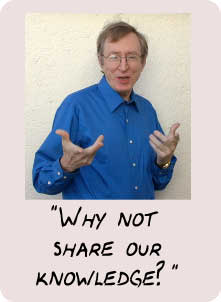|
|
Katalina Groh, Larry Prusak: Some of the world's leading thinkers |
| Storytelling to ignite change: Steve Denning |
 |
Why
not share our knowledge?
Then I started to have a different thought. I said to myself: “Why don’t we share our knowledge?” Over the previous fifty years, we had acquired immense expertise as to what worked and what didn’t work in the field of development. We had all this know-how on how to make development happen in countries around the world. But it was very hard to get access to this expertise and know-how. It was very hard to find it. If you were inside the organization and you knew somebody who had the expertise, and could talk to them, you were o.k. But if you didn’t know someone, you were in trouble. And if you were outside the organization, it was practically impossible to get access to the World Bank’s expertise unless you were engaged in a lending operation. |
| So there were only very few people around
the world who were actually benefiting from the World Bank’s immense expertise.
The lending organization But I started to ask myself: why don’t we share our knowledge more widely? Technology was changing and it was now becoming possible for us, if we so chose, to share our knowledge with the whole world. It was becoming possible for us to become a knowledge sharing organization, and in the process, we could be a pretty exciting organization with a bright future. But when I explained this idea to some of my colleagues, their reply was quite blunt. They said, “Steve, this is the World BANK! We are a lending organization, always have been. Lending is what keeps the organization going. It’s what pays your salary. Keep your eye on the ball! Knowledge might be interesting, but this is basically a lending organization.” Charts I could see that didn’t
work, and I started to ask myself how was I going to persuade this organization
to change. I thought about what the consultants did and I knew they used
charts and slides with boxes and arrows. And so I started showing slides
like this slide from Professor Nonaka’s wonderful book on The Knowledge
Creating Organization. It shows the knowledge spiral, going from the process
of socialization, to externalization, to combination and so on. And when
I showed this chart inside the World Bank, there was an expression on people’s
faces that showed that the chart was not at all having the effect that
I had intended.
Dialogue is impractical
|
| Books and videos on storytelling *** In Good Company : How Social Capital Makes Organizations Work by Don Cohen, Laurence Prusak (February 2001) Harvard Business School Press *** The Social Life of Information, by John Seely Brown, Paul Duguid (February 2000) Harvard Business School Press *** The Springboard : How Storytelling Ignites Action in Knowledge-Era Organizations by Stephen Denning (October 2000) Butterworth-Heinemann *** The Art of Possibility, a video with Ben and Ros Zander : Groh Publications (February 2001) |
| The views expressed on this website are those of the authors, and not necessarily those of any person or organization |
| Site optimized in 800x600: webmaster CR WEB CONSULTING |
|
|
|
|